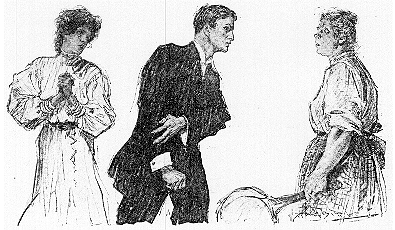The Psychology of Woman's Dress
PROFESSOR IN THE UNIVERSITY OF CHICAGO. AUTHOR OF THE THE ADVENTITIOUS CHARACTER OF WOMAN, ETC.
WITH ILLUSTRATIONS BY JAY HAMBIDGE
THE advances which modern life has made over savagery are represented at some points by a very thin line. Old practices are refined, the old forms are presented with slightly different coloring and arrangement. and the emphasis is placed at different points but we do not get clean away from the old patterns. Savage life, in its turn, borders very close on the animal, and sociology and psychology must continually go back to the simpler conditions of animal life to pick up the cue.
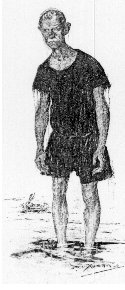 Man is naturally of animals, without natural glitter, with no
plumage, no spots or stripes, no naturally sweet voice, no attractive odor, and no
graceful antics. But, thanks to his hands, he has the power of collecting brilliant
objects and attaching them to his person, and he thus becomes a rival in radiance of the
animals and flowers.
Man is naturally of animals, without natural glitter, with no
plumage, no spots or stripes, no naturally sweet voice, no attractive odor, and no
graceful antics. But, thanks to his hands, he has the power of collecting brilliant
objects and attaching them to his person, and he thus becomes a rival in radiance of the
animals and flowers.
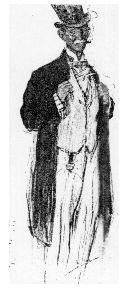
But we have to go no further than the barnyard to witness an apparatus for display which man has never equaled. The turkey-cock with his glittering plumage, his finely zoned tail and barred wing-feathers, and his crimson and blue wattles, is really a one of the most unadorned brilliant appearance or superb spectacle. Mr. Wallace reports that when a dozen or more full-plumaged male birds of paradise congregate in a tree to hold a dancing-party. as it is called by the natives. they fly about, raise their wine;, elevate their exquisite plumes, and make them vibrate until the whole tree seems to be filled with waving plumes. Many species of birds habitually adorn their nests with gaily colored feathers, wool, cotton or other gaudy material. In many cases a marked preference is shown for particular objects, as. for instance. in the case of the Syrian nuthatch. which chooses the iridescent wings of insects, or that of the great crested fly-catcher, which similarly chooses the cast-off skins of snakes. But no doubt the most remarkable of these cases is that of the Baya bird of Asia, which studs its bottle shaped and chambered nest with small lumps of clay, upon which the cock bird sticks fireflies apparently for the sole purpose of securing a brilliantly decorative effect. Other birds, such as the hammer-bird of Africa. adorn the surroundings of their nests, which are built upon the ground, with shells, bones, pieces of broken glass and earthenware, or any object of a bright and conspicuous character which they may happen to find.
This purveying and wearing of or-
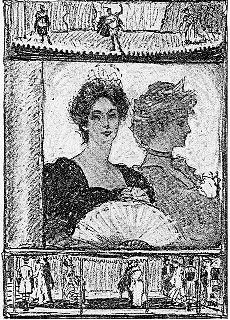
(67)-nament, peeping out from behind finery, and waving of plumes is so near the type of interest of the savage and the fine lady, with their paint and feathers, and even of the twentieth-century melodrama' with its calcium lights and chorus girls, that you could not put a knife-blade between is witty,'' says Peer Gynt, and one of her sallies was to give man his "noble mind" and yet leave him with a predominant interest in the turkey-cock pattern of interest, without natural equipment for competing.
No race is so low in culture or so wretched in condition as to dispense with ornament. Darwin gave a shivering Fuegian a piece of red flannel, and was surprised to find that he had torn it in strips and made leg ornaments for himself and his wretched companions. The African belle produces the glossy effect of black silk or of polished ebony by rubbing her body with butter. The Hottentot gathers his scant woolly hair into tufts and ties to each a rabbit's tail, a brass button, or a piece of bone; or he smears his hair with a mixture of red ocher and fat, so that it sticks to his head like a scarlet cap. The Tupis of South America produce a brilliant and startling effect by pasting the skin and bright orange-colored plumage of the toucan's breast on their cheeks To perfect the coiffure of the African Latookas requires a period of from six to eight years.
In a single district in Africa four hundred varieties of beads are known by name, and the passion with which this interest is pursued isindicated by such significant names as " food-finishers," " home-breakers, " and " town-destroyers."
To his apparatus for charming, savage man has added long-haired, snow-white monkey and goat skins, and the striped and spotted skins of the leopard and tiger; kilts of cat and monkey tails, of zebra mane, black cocks' feathers, and flowers; shell alla hair necklaces; feather boas and white down attached to the body by using blood as a glue; tattooing as delicate as lace or as gaudy as calico; red, yellow, and white pigments for the skin, and stains for the teeth; bracelets and anklets of copper and silver, aggregating sometimes thirty pounds in weight; and the art of lacing, not by the use of a corset, but by a belt or cord worn around the waist and tied so tight that, as Captain Cook describes it, the shape of their bodies is not unlike that of overgrown ants.
Indeed, if we made a complete inventory of savage man's devices we should, I believe, find that he had overlooked nothing fundamental. And if he had copyrighted his devices modern woman would be under the necessity of paying him handsome royalties; for it is one of the first principles of patent law that the substitution of new materials and "transferred uses" do not constitute invention. Note also that it is the African who has shown the most genius in this line, or at any rate he has stopped at nothing.
Bright spots and a flashy exterior seem trivial possessions, but they are a part of the out-
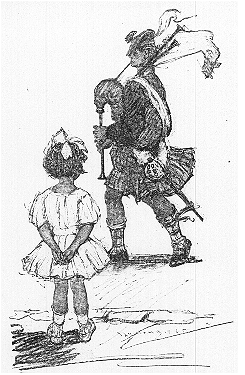
(68)-fit for charming the opposite sex. The more brilliantly ornamented male makes a more powerful impression on the female and is successful in courtship, while the less highly ornamented male leaves no offspring. There is therefore a constant process of selection which results in the marvelous brilliance of the males of some species.
Among men also the instinct for showing off is primarily sexual, but since in their case the possession of attractive objects is often the result of skill and bravery, ornament comes to mean that its bearer is a formidable and powerful person. It is therefore a sign of manhood and heroism and is a means of securing a high rating by both men and women. In this connection we have an explanation of the " barbaric splendor " which characterizes all early governments. With the growth of democracy, and the emphasis of action rather than a show of ancestrally accumulated signs to success, there is a tendency to deprecate and even deride display; but that the old instincts linger is shown by the fact that there is no country in the world where lavish display is not impressive and effective in creating and maintaining social distinctions.
Clothing, as distinguished from ornament and dress, had a particular development in cold climates. It is characteristically arctic, while ornament is characteristically tropic. When a man wants warmth the most natural thing is to reinforce his own skin with another skin. The clothing of the arctic regions therefore follows the outlines of the body as closely as possible and both the men and women wear trousers. In the tropics, ornaments were suspended at those portions of the body from which they would not readily slip off -- shoulders, waist, ankles, and wrists. The covering wore at the waist was at first beads. shells, feathers, grass, flowers, animals' tails, and fringes of skin.
On moving into a cooler climate man adopted trousers because they suited his more exposed and active life, but woman, being more conservative and less exposed, has clung to the old fashion, and merely dropped the waist-fringe to the feet, thus unconsciously setting a fashion which has never been changed. because it has become of value as a mark of sex. The blouse is similarly the ornament originally worn around the neck, extended until it meets the skirt at the waist. The Scotch kilt is a case where the girdle was not extended all the way down. but stockings were extended part of the way up, the two not quite meeting.
For instinctive reasons which we do not control and do not completely understand, signs of sex have very powerful emotional effects, and it is even true that any object habitually associated with either sex takes on some of the personality of that sex. Not only the long hair of woman but even her handkerchief may have a vivid interest for the lover. The mannish woman is one who drops some of the signs of her sex. The clothing of woman, when it was developed to the point of covering her whole person, took on an interest of its own, but it had the disadvantage of obscuring the figure. This difficulty has been met by fashioning the clothing on lines which
(69) indicate and even emphasize the outlines of the body.
To be short on this point, which does not require elaboration to a person who uses his eyes, the dominant idea in the historical fashions of woman's dress is emphasis of the waist line. The most striking anatomical peculiarity of woman is a waist which measures small in comparison with the bust and hips. This point can be emphasized further either by artificially constricting the waist or by adding on structure at the hips or shoulders. The balloon sleeves, the bustle, the pander, and the hoop-skirt are as effective in this as the corset. The tapering hand and the foot, and the taper toward the feet secured by the pinch-back skirt are equally effective contrasts with the hips and bust. The dress of the Eastern woman is designed to conceal the outline of the figure, that of the Western woman to reveal and emphasize it.
Relatively small and weak hands and feet are another distinctive mark of woman, and to render these more dainty has been another persistent effort of fashion. High heels, like long skirts, add to this apparent magnitude of woman, and at the same time give her a delicate and distinguished underpinning. If, then, a woman walks on her toes and places the heel of the shoe under her instep instead of under her heel, and if the skirt so covers the foot. that the shoe-heel seems directly under the real heel, we get the spectacle of a very small foot indeed. The shortened length attained by Chinese women through doubling the toes back is secured by the Western woman by means of the high and illusorily placed heel.
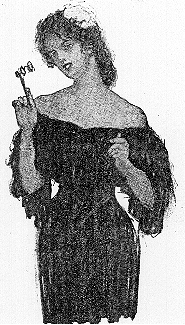 The habit of wearing ornament
has naturally been somewhat modified by the introduction of showy and dainty fabrics worn
over the whole person. The fabrics are not only more changeable than jewels, but the
successful imitation of precious objects renders the wearing of them in profusion
suspicious in all except the very rich, and an incredible amount of ornament does the
wearer more harm than good. We call this bad taste, and what we really mean is that the
majority have recognized that it is no longer an effective mode of display. Still, it is
hardly true to say that the total amount of ornament has been diminished by the
development of a form of dress covering the whole person. The ingenuity of man has found a
place on woman s dress for every object worn by savage man, and for those for which no
other place was found he has devised the hat.
The habit of wearing ornament
has naturally been somewhat modified by the introduction of showy and dainty fabrics worn
over the whole person. The fabrics are not only more changeable than jewels, but the
successful imitation of precious objects renders the wearing of them in profusion
suspicious in all except the very rich, and an incredible amount of ornament does the
wearer more harm than good. We call this bad taste, and what we really mean is that the
majority have recognized that it is no longer an effective mode of display. Still, it is
hardly true to say that the total amount of ornament has been diminished by the
development of a form of dress covering the whole person. The ingenuity of man has found a
place on woman s dress for every object worn by savage man, and for those for which no
other place was found he has devised the hat.
Rapid rotation in style is a device to attract attention not known to animal life and not systematically used in the Orient. The Woman of the Far East uses expensive and attractive materials, but she wears them, as she does jewels, for a long period. Among Occidental women the discarding of dress is not only seasonal but, if it can be afforded, diurnal. The constant change is not only striking in itself, but the economic ability to make it distinguish both the woman and the man whom she represents. What Mr. Veblen happily terms " conspicuous waste " is a means of distinction which the masses are not in a position to copy.
Personal display is dangerous ground for woman, since it involves disgust in the spectator when overdone, and she would never be bold enough to carry it to such outspoken lengths if she were not operating in a flock. She is timid about emphasizing herself except as one of a flock, but she is anxious for all the conspicuousness she can get in the flock, and is above all concerned to be a member of the
(70) most distinguished flock. At this point she shows some independence of man and almost loses sight of him (after marriage, at least) in her interest in outstripping other women. Men would prefer her more simply dressed; but this is her game -- indeed, it is almost her business.
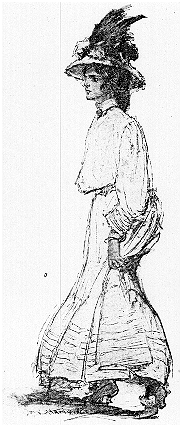
As society advances there is a tendency in man to give up ornament and in woman to take on more of it. This is not because man is naturally less inclined to display, but because he has undergone a great reform in his habits, the greatest perhaps in the history of the world. Primitive man was social, ostentatious, and lazy, but capable, crafty, and masterful -- your true adventurer, but endowed with an inventive imagination and capable of splendid bursts of energy. This was the wild-oats period of the race, and its vestiges are still seen in the gamester, the artist the wild youth, and the dissipated husband.
But when man exhausted the game enrich had been his principal pursuit and began to take up the settled manufacturing and agricultural interests which had been chiefly developed by woman, and to buy and sell, he brought with him more ingenuity than w o m a n had ever developed, a freer movement, a greater power of organization, and at the same time less domestic responsibility, and he gradually transferred some of his interest in the pursuit of game to the pursuit of business. But business lies, so to speak, outside the region of appearances. It is primarily a matter of judgment, efficiency, and energy, and if a man has efficiency and wealth in abundance he is attractive enough without ornament. No one ever completely loses an interest in bright objects, but business men take advantage of this fact to display their goods, not their persons. The color sense and the sexual interest are recognized in the display, wrapping and advertising of wares. The glaring bill board and the beautiful lady on the cigar-box saturate the goods with color and sex, and we buy them on that basis. But a pretentiously housed business and a handsomely gowned wife are also capital advertisements; they are signs of business success, and ' nothing succeeds like success."
We must not, of course, imagine that man set deliberately about abandoning ornament. Specialized occupations became more effective means of getting his results than personal display, and he gradually went over into them. Neither is his ornamental nature fundamentally altered. He dips into ornament in adolescence, before he has regularly become harnessed to an occupation, and he keeps up his interest in the spectacular vicariously, in his patronage of "shows" of all descriptions; but money is his main charm.
Woman, on the other hand, is not naturally spectacular, but rather reserved, and, as I pointed out in the last paper, it was only when man had acquire] a specialized skill which gave him a mastery of the world, and her person as well, that woman began to specialize the display which he was abandoning. Restricted in movement, with no specialized skill, with not even life to educate her in the broad sense in which men encounter it, and limited in her interests by the proprietary tastes of man, her occupation is to charm.
There is, however, both retribution and irony in the fact that man pays the bills. An inventory of the activities of the world will
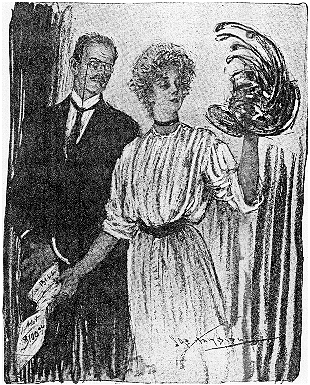 (71) show that they are carried on by man largely as a means of
supplying woman with those accessories which she uses to charm him. The materials which
she demands are rare, costly, varied, and changeable, and the members of the learned,
professional, and artistic occupations combined are outnumbered by those whose business is
to manufacture and sell objects relating to woman's dress. In France alone there are more
than two and a half millions of workers on clothing and the materials of clothing, and
about a million of workers in textiles. The annual silk output of the United States and
Europe is valued at four hundred million dollars and the textile output at nearly four
billions -- all mainly for women.
(71) show that they are carried on by man largely as a means of
supplying woman with those accessories which she uses to charm him. The materials which
she demands are rare, costly, varied, and changeable, and the members of the learned,
professional, and artistic occupations combined are outnumbered by those whose business is
to manufacture and sell objects relating to woman's dress. In France alone there are more
than two and a half millions of workers on clothing and the materials of clothing, and
about a million of workers in textiles. The annual silk output of the United States and
Europe is valued at four hundred million dollars and the textile output at nearly four
billions -- all mainly for women.
The dress of woman has, in fact, become so incorporated in business that, as Sir Henry Maine has pointed out, the greatest calamity which could be conceived as befalling great populations would be, not a sanguinary war, a desolating famine, or a deadly epidemic, but a revolution in fashion under which "women should dress, as men practically do, in one material of one color. There are many flourishing and opulent cities in Europe and America which would be condemned by it to bankruptcy or starvation, and it would be worse than a famine or pestilence in China, India, and Japan." That is to say, any great change in our industrial system must be gradual not to be calamitous
But, while woman's demands occupy so large a place in the industrial world, it is noticeable that she is herself only a pawn in the industrial game played by man. Her individual possessor uses her as a symbol of his wealth, and the captains of industry make her and her changeable and expensive fashions the occasion of a market for the costly and changeable objects which fashionable habits force her to accept. New fashions are not always beautiful; they are even often ugly, and women know it: but they embrace changes as frequent and as radical as the ingenuity of the modemakers can devise. Women do not wear what they want, but what the manufacturers and trades-people want them to want. The people who supply them also control them.
This does not, however, alter the fact that the general tone and pace of social life are deeply influenced by woman's emphasis of finery and form. There is an old story of a lady who purchased a pair of brass andirons
(72) and then by degrees persuaded her husband to refurnish the whole house to match them. Just so, when silks and furs and gems and lace and the unminted gold are attached to the person of woman, it follows also that the household and the world in which she moves are transformed to harmonize with her showy taste and appearance. Beginning with the rugs, tapestry' porcelain, silver plate, fine linen, and the - rich and gaudy furnishings of the home, the factitious personality of woman pervades and bedizens everything. The baffling array of silver at the twelve-course dinner and the costly box at the costly opera are equally a part of woman's dress. This situation is the despair of men, but it is " society."
The effect of this situation on the character of woman is altogether bad. One interest expels another or prevents its development. The proverbially hollow mind of the very beautiful woman is not due to the exhaustion of nature's resources on her exterior, but to the fact that her attention is so bound up with the expression of her own charm that it stops with that. And the homely woman who competes with her has a still more absorbing problem. The foolish and disrespectful customs of courtesy which men practice toward women are also a' product of woman's dress, and tend to keep her-helpless in mind and body. The helplessness involved in lacing, high heels, undivided skirts, and other impedimenta of women has a certain charm in the eves of man. Their helplessness shows him off better by giving freer play to his protective and masterful instincts. It is his heroic opportunity since the disappearance of large game and in the "piping times of peace." To flatter this disposition of man, woman therefore assumes even greater helplessness than she possesses, and the most romantic periods in history are those characterized by tight lacing and purposive fainting
The role of " half angel and half bird" is a pretty one, if you can look at it in that way; but it denatures woman, makes her a thing instead of a person, a fact of the environment and an object of man's manipulation instead of an agent for-transforming the world. It leaves society short-handed and the struggle for-life harder and uglier than it would be if woman operated in it as the substantial and superior creature which nature made her. We have a machine-made civilization which has introduced class-inequalities, hatred, and suffering- unknown in savagery or barbarism. We are wealthy but-not humanized. Man is pursuing business on the same pitiless principle that he formerly pursued game. Women omen have a base of maternal feeling that makes them more social than man, and if the economic value of the superfluity of their dress and the energy and attention they waste in following the fashions were devoted to humanistic enterprises we should be in a fair way to add the elements lacking to make our machine system a civilization. But there is no use trying to tall: fashions down. The change will come gradually. as women become more intelligent and independent and of themselves " experience the expulsive power of a new affection."
